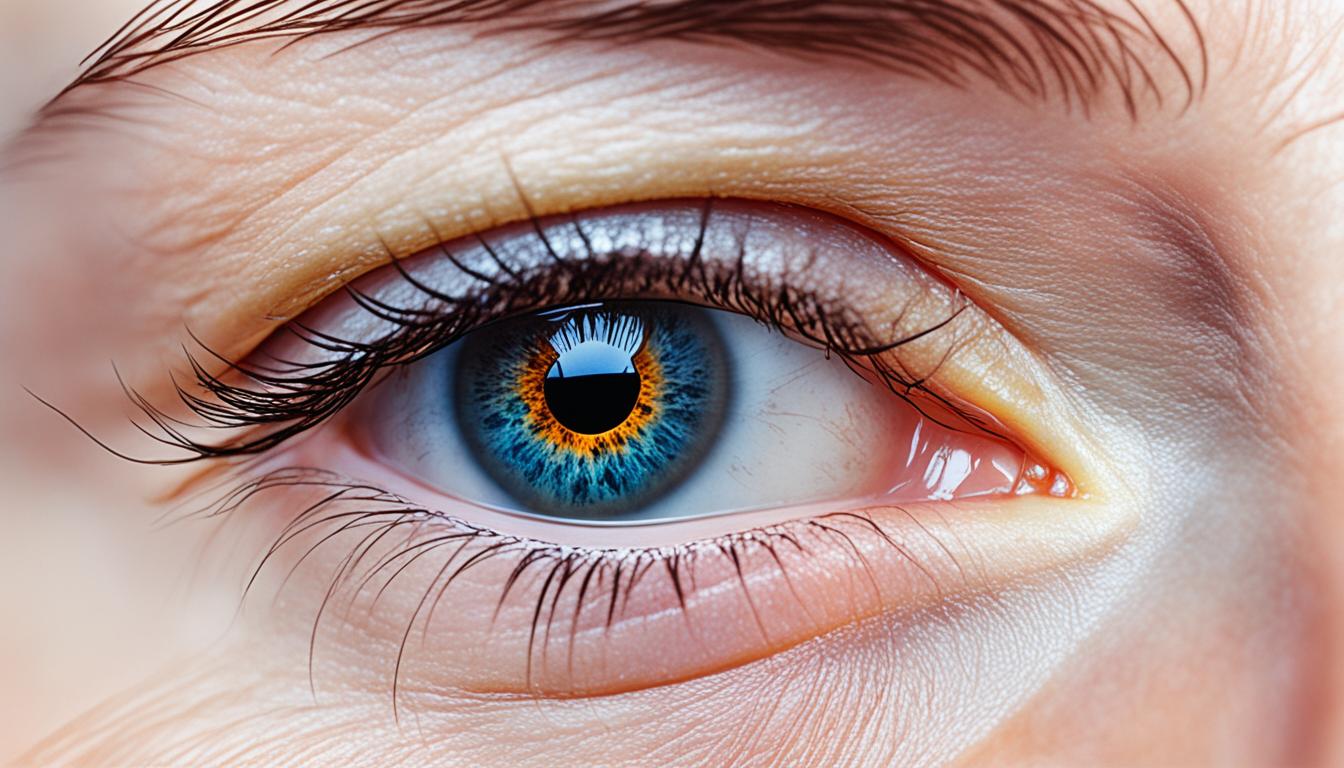Melanoma of the eye is a rare cancer that mainly affects the uveal tract. This includes the iris, ciliary body, and choroid. It is the top eye cancer in adults, with around 5 people per million getting it.
Risk factors for this cancer include having light-colored eyes and fair skin. People who can’t tan or easily sunburn are also at risk. While we don’t know the exact cause, both genetic and environmental factors play a part.
Eye melanoma shows different symptoms in each person. These can be blurred or double vision, eye irritation, or pain. Some may see flashes of light or even lose vision.
To diagnose eye melanoma, a doctor will do a thorough eye exam. They may also use imaging tests like fundus photography, ultrasound, and angiography.
Treating eye melanoma involves various methods. These can be surgery, radiotherapy, and laser options. There’s also an exciting new approach, stem cell therapy, showing potential in fighting this cancer.
Key Takeaways:
- Melanoma of the eye is a rare form of cancer that mainly affects the uveal tract.
- Common risk factors include light-colored eyes, fair skin, and an inability to tan.
- Symptoms can include blurred vision, double vision, and pain.
- Diagnosis involves a comprehensive eye examination and imaging tests.
- Treatment options include surgery, radiotherapy, laser therapies, and stem cell therapy.
Diagnosis and Treatment of Melanoma of the Eye
Finding out if you have eye melanoma starts with a lot of checks. Doctors look closely, ask about your health, and test how well you can see. They might take pictures of your eye, use sound waves (ultrasound), or look at your eye’s blood flow (angiography). This helps them see how big and where the tumor is.
After diagnosing eye melanoma, the next step is figuring out how to treat it. Treatments will change based on the tumor’s size, where it is, and if has spread.
For tumors that haven’t spread, you have local treatment options. One is to remove the tumor with surgery. This surgery, called enucleation, tries to save as much of your eye as possible. But sometimes, they can just cut out the tumor if it’s small and hasn’t spread.
There’s also radiotherapy. It uses high-energy radiation to kill cancer cells. This can be done from the outside (external) or from the inside of the eye (internal). They also use laser treatments to kill the cancer cells.
If the melanoma has spread, there are other treatment choices. Some treatments target long melanoma in the liver. Doctors may cut out parts of the liver with cancer. Or they could use special therapies, like putting chemo drugs straight into the liver’s blood vessels.
More options include drugs given throughout your body (chemotherapy) or drugs that target just the cancer cells (targeted therapy). Targeted drugs aim at the specific changes in the cancer cells to stop them from growing.
It’s important to keep seeing your doctor after being treated for eye melanoma. Regular check-ups help them find any new growth or if the cancer has come back. This way, they can pick the best treatment if needed.
| Treatment Options for Melanoma of the Eye | |
|---|---|
| Local Therapy Options | Locoregional/Systemic Therapy Options |
|
|
Advances in Stem Cell Therapy for Melanoma of the Eye
Stem cell therapy brings hope for treating uveal melanoma, a rare eye cancer type. Researchers are looking at how cancer stem cells are involved. These are special cells in a tumor able to make more of themselves and change into various cell types.
Cancer stem cells seem key in starting, growing, spreading, and battling therapies. By aiming treatments at these critical cells, new, more effective strategies could be found. This could be good news for people fighting uveal melanoma, possibly bettering their outlook.
Experts are trying different ways to get rid of these harmful cancer stem cells. They’re exploring immunotherapy and other targeted treatments. Though early investigations show hope, more studies and tests are vital. This helps see if and how safe and beneficial stem cell approaches can be in eye melanoma care.
Advancing in stem cell therapies is exciting for the future of dealing with uveal melanoma. As research and treatments progress, stem cell therapy might offer new possibilities. This offers a glimmer of hope for those dealing with the difficulties of this eye cancer.
FAQ
Q: What is melanoma of the eye?
A: Melanoma of the eye is a rare cancer. It mainly affects the uveal tract. This includes the iris, ciliary body, and choroid.
Q: What are the risk factors for melanoma of the eye?
A: Risk factors are having light-colored eyes and fair skin. Also, if your skin can’t tan or burns easily, you might be at risk.
Q: What are the symptoms of melanoma of the eye?
A: You might see blurred or double vision. Other symptoms include eye irritation, pain, and flashes of light.
And you can also experience loss of vision.
Q: How is melanoma of the eye diagnosed?
A: Doctors diagnose it with a comprehensive eye exam. They also use imaging tests, like fundus photography, ultrasound, and angiography.
Q: What are the treatment options for melanoma of the eye?
A: Treatments include surgery, radiotherapy, and laser therapies. Stem cell therapy is also an option.
Q: What is stem cell therapy for melanoma of the eye?
A: Stem cell therapy is a new promising treatment. It’s for uveal melanoma.
Q: How is stem cell therapy being used in the treatment of melanoma of the eye?
A: Studies look into using stem cell therapies. They aim to get rid of cancer stem cells in uveal melanoma. This includes using immunotherapy and targeted therapies.
Q: What are the advancements in stem cell therapy for melanoma of the eye?
A: New research shows that cancer stem cells play a big part in uveal melanoma. Targeting these cells could be a new way to treat the disease. It might also improve how patients do.

